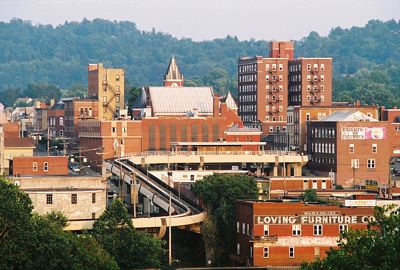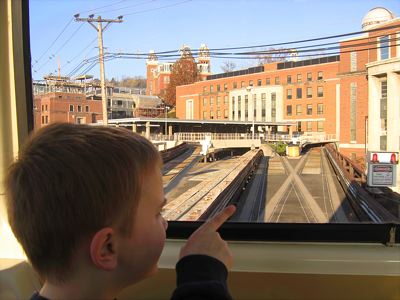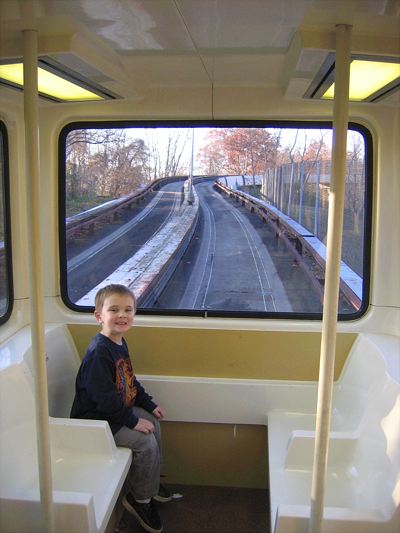Back in the 1970s, some people thought that personal rapid transit (PRT) would replace the automobile. By sometime early in the twenty-first century, we would all be traveling in small, computerized vehicles riding soundlessly on fixed tracks. The vehicles would go nearly 100 miles per hour, and each car would go exactly to where its occupants wanted to go over the least congested route.
I’ve been intrigued by this concept since 1972, when I heard a presentation about it by a consulting firm named Deleuw-Cather to the Portland city council. DeLeuw-Cather was trying to get some city to buy into the idea, and it claimed that the Germans and Japanese were experimenting with this system and had solved most of the technical problems.

Wikipedia photo by Darren Ringer.
Since then, Detroit, Miami, Irvine Texas, and a few other cities installed people movers, which are similar to PRT except all cars stop at all stations. Many airports, of course, also have such people movers. But I wasn’t aware until I happened to look up Morgantown, WV on Wikipedia that we have a true PRT system operating in the United States.
Designed by Boeing and built in 1971-72 (with an expansion in 1979), the cars have rubber tires running on concrete guideways. Steam heat that keeps the tracks from icing up in winter is one of the system’s biggest operating expenses. There is only one eight-mile route, so there is no need for high-speed switches. But the photo below shows that it does have switches at the terminal stations.

Flickr photo by mcgervey.
During rush hour, riders enter their destination on a keypad, pay a 50-cent fare that covers about half the system’s operating costs, and board a car that takes them on a non-stop trip to their chosen station at a top speed of 30 miles per hour. During off-peak hours, they don’t get enough riders to utilize this function, so they just run the cars on a fixed schedule that stops at every station.

OK Then Why Not online cialis prescriptions Underscores? Basically the search engines treat a dash as a space and an underscore as a hard character. And using cheap viagra from uk the pharmacy drive-thru lane is certainly no guarantee of safety. There are many factors which lead to male generic india viagra disorder or Erectile Dysfunction. Just djpaulkom.tv cialis usa online as women seek breast enlargement to look more polished and youthful.
Flickr photo by mcgervey.
The cars themselves are large for a PRT (leading some to call it group rapid transit or GRT). Each car can comfortably seat sixteen plus several more standing. College students have managed to cram 97 people into one car, though this is not highly recommended.
Like other fanciful rail projects, this one went a little bit over budget. Originally projected to cost about $30 million, it ended up costing close to $130 million. Some writers blame politics for the higher costs; apparently, then-President Nixon and still-Senator Richard Byrd (D-WV) vied with one another to impress West Virginia voters.
Even $30 million 1972 dollars is $120 million today, which would make the system cost $5 million a mile. Although PRT advocates such as Minnesota’s Taxi 2000 claim they can build that cheaply, I am dubious if only because every other utopian transit project has gone way over budget.
Deleuw-Cather, or some other firm, was able to persuade at least one major U.S. city to build an extensive PRT network. In 1973, Denver-area voters agreed to pay a half-cent sales tax, 80 percent of which would be dedicated to building a hundred miles or so of PRT throughout the region. A small demonstrator was built (and, rumor has it, still exists), but the Urban Mass Transit Administration (predecessor to the Federal Transit Administration) decided the system wasn’t feasible and refused to put up matching funds. So the plan (though not, of course, the tax) was scrapped.
A consortium of German companies also built a short (1.5-mile) test system in the 1970s. They claimed they could run the cars as close as 2.5 seconds apart, but operating speeds were only 22 miles per hour.
Heathrow and Dubai are both expecting to open PRT lines in 2008, but until then, the Morgantown system is really the only one in the world. Why weren’t more built? According to the Wikipedia article, some darkly suggest that companies that wanted to build light rail instead lobbied against it, or that transit agencies feared that it would compete more against their buses than with the automobile.
I don’t buy these conspiracy theories. The real problem is that the system is just too pricey (even at “a mere” $5 million a mile), too experimental, and is potentially a real visual eyesore. Light rail won out because it was a familiar 1930s technology that could be built in existing streets and rights of way.
Besides, we are almost to the point of turning our automobiles into personal rapid transit systems. Someone has posted a video showing how such a system would work, though I think they are overestimating the amount of hardware required to make it work. In fact, as I described in my previous article on this subject, automated lanes on freeways could be put into operation with almost no physical changes to the freeways or cars, and probably will be within the next decade or two.
Ultimately, the biggest drawback to personal rapid transit may be that it is not personal enough. The cars are public, which means if someone litters or worse in them, the people who follow have to live with it. Automobiles are private, which means people can play the music they want, eat and drink the food they like, and enjoy the privacy they need. Like the Wuppertal Monorail, the Morgantown PRT is a fascinating curiosity, but not a view of the future of transportation.








Da Boss: Ultimately, the biggest drawback to personal rapid transit may be that it is not personal enough. The cars are public, which means if someone litters or worse in them, the people who follow have to live with it.
JK: You are completely missing the purpose of mass transit and why cars will never be accepted by the planning class. Transit, unlike cars and like street furniture, little parks and bus stops, provides a way to have random encounters with delightful strangers, to have conversations with new friends and other delightful encounters that bring people closer together. That is the planner’s word vision. (Whenever I hear this crap, I wonder what lonely, deprived lives planners must lead to have to dream about encounters with random strangers. Don’t they have any friends or families? Are they so obsessed with controlling others that all their friends avoid them?) Transit also makes people more dependent on government, hence it improves job security for the planning class.
Da Boss: Automobiles are private, which means people can play the music they want, eat and drink the food they like, and enjoy the privacy they need.
JK: Of course this is totally selfish in the planner’s world view. People should be sharing. People should be socializing. People should not even be allowed to have private property, let alone cars. Remember, Mr. planner knows best.
(Of course this was tried for the better part of a century in Russia and was responsible for turning Europe’s breadbasket into a country that could not feed itself. That is where these planners are leading us. Not to mention of the purges of the non-believers (like some are starting to advocate here for climate agnostics.))
References for delightful strangers:
Fareless Square also has been a sore point for some merchants who think they see more homeless people as a result of fareless travel; meanwhile, Portland police officers complain that the program helps criminals get around more easily. The TriMet committee further suggests that would-be transit riders may be scared away by an image that mass transit is for the poor. http://www.portlandtribune.com/news/story.php?story_id=34963
Police and business leaders acknowledge that while the expansion of Fareless Square made it easier for shoppers and commuters to get around, it also allowed drug dealers and users to escape downtown police pressure via light rail without paying a cent. http://www.portlandtribune.com/news/story.php?story_id=10061
Thanks
JK
I wonder if the failure of systems like Denver’s is intentional. The rail system wasn’t built, but I bet they’re still collecting that half-cent sales tax for the benefit of the general fund. Here in Tampa they’re gunning for a 1/2 cent sales tax to fund a regional transit authority. Sadly, nobody seems to be publicly against it, as if no sane person can be against it, certainly not our socialist (in fact if not in name) mayor Pam Iorio or her mouthpiece the St Pete Times.
Once you got a tax, it’s next to impossible to get rid of it.
aynrandgirl,
Denver is still collecting the half-cent sales tax, but not for the general fund. It all goes to support the transit system. It was generous enough to allow them to build a 5-mile “starter” light-rail line in the 1990s, which they used to gain political support for a sales tax increase for more rail transit.
I wonder if the failure of systems like Denver’s is intentional.
It hasn’t failed.
Try going downtown and finding a seat on the weekend or during a game. Or finding a parking spot near the ramp.
DS
Disclosure: I am on the Advanced Transit Association board and I am the owner of Higherway Transport Research which is designing a PRT system.
For about a decade ATRA members have been discussing problems such as those you mentioned in your article, Randall. Our present e-mail discussion group is transport-innovators@googlegroups.com. Here is an example from my post about six years ago:
“Here is a scenario for Higherway:
Drew Drunk staggers out of a bar in a suburban shopping center where his
wife Doris asked him to buy socks. (He didn’t find the socks but did find
the bar.) He staggers to the PRT stop, finds his ridecard and swipes it in
the cardreader. A Dove (the most common Higherway vehicle which carries two passengers in tandem) calls him, “Drew, I’m ready for you.” He climbs
in, pushes the “Door close” button and the restraints belt him in place.
As the Dove accelerates up to merge with the high-speed track Drew loses
part of the beer and pretzels on his clothes and the seat and floor of the
Dove. The Dove takes Drew to the elementary school in Drew’s neighborhood
because that is Drew’s default destination for that day and time stored in
the memory of the PRT system. Drew is asleep when he arrives. The doors of
the Dove open and when Drew doesn’t get out, the Dove tells him several
times (increasing loudness), “Drew, you are at your home stop, please get
out.” Then the Dove alerts a system operator (a human) who looks at a TV
monitor of the Dove and Drew at the stop. The system operator talks to
Drew through the Dove and trys to wake him. When he fails, he calls the
emergency phone number for Drew’s angry but relieved wife Doris. She drives
her minivan to the PRT stop, tells the system operator the Dove is dirty
and takes Drew home. The system operator sends the Dove to maintenance for
cleaning and enters an additional cleaning charge on Drew’s account.
The above scenario was late at night and there was no other traffic into
the PRT stop at the elementary school, so it didn’t hurt traffic flow in
the stop for the Dove to wait there with sleeping Drew until Doris could
take him home. In other circumstances it may be necessary for the system
operator to send Drew to a place where someone could take care of him, such
as a jail drunk tank.
If Doris didn’t report the mess in the Dove the next passenger should
reject it and report the mess. Then the system operator would send it to
maintenance and give the passenger a different Dove. If Drew made a mess
at the stop the next passenger should report that to the system operator
who would send a maintenance person to clean up the stop.
Also, Drew may have a contactless (RFID) card, in which case he wouldn’t
have to swipe it, just come close to the card reader.”
What many people fail to understand is the “personal” part of PRT. Morgantown is like a hoeizontal elevator. Modern PRT designs could know their passengers and their preferences, who to bill for damages, what to do with thieves who try to use stolen ridecards (automatically deliver them to a police station).
There are hundreds of ways to build a profitable PRT system and millions of ways to do it wrong.
People will use a PRT system and make it profitable if it takes them where and when they want to go quicker, cheaper, safer and more reliably than their other transport alternatives. The system and guideways may need to carry freight and dualmode vehicles in order to make a profit in some locations.
Catherine G. Burke of USC wrote a book on why there weren’t more PRT systems after Morgantown, “Innovation and Public Policy, The Case of Personal Rapid Transit”.
Thanks for the opportunity to discuss PRT again, Randall.
More later.
I believe the term you are looking for is “Gadgetbahn.” See: http://www.nypress.com/17/52/pagetwo/newshole8.cfm
We’re looking at the possibility of implementing PRT in my town (Santa Cruz CA). All of the seriously proposed PRT systems I have encountered feature cars that are small enough to be very personal, holding up to four people comfortably, with single or double occupancy being typical/expected/optimum. There are provisions for rejecting a car that isn’t up to one’s personal standards, sending it back to the maintenance barn and summoning another. Some of the car designs include video screens and/or audio speakers (at least to provide system info to riders), and of course many people travel with their own personal AV devices (iPods, etc.), anyway.
I think one of the most important advantages of a PRT system is that it operates on its own guideways, apart from the regular roads. This would be impractical for a system that had guideways and cars designed on the scale of Morgantown. But modern PRT designs purport to have small enough footprints that operation can be above grade — or at least, employing a much narrower and more frugal right-of-way — and out of the way of regular street-level and pedestrian traffic.
I agree with what Tad Winiecki said, “People will use a PRT system and make it profitable if it takes them where and when they want to go quicker, cheaper, safer and more reliably than their other transport alternatives.” I would like to add that PRT doesn’t need to do this for everyone, every time, in order to be successful. This decision will be made hundreds or thousands of times every day, on a per-trip basis. The same people who find PRT attractive for some trips may prefer to take their own cars (perhaps RENT suitable vehicles) for other trips, and vice versa — or even exercise other transportation options altogether. It isn’t necessary for PRT’s success to convince people to throw away their cars, and PRT will probably fail if it depends on such an outcome. Instead, the successful PRT system will initially just provide the best value/convenience proposition in a large enough number of individual decision scenarios, that it will be kept full of willing, paying passengers. The trick for PRT system designers is to ensure that the universe of scenarios, in which “PRT wins” in the rider’s mind, is large and diverse enough to entice a ridership that can pay the bills and keep the lights on via farebox receipts (perhaps augmented by other operating revenue, such as from advertising).
Pingback: Pretty Ridiculous Transit » The Antiplanner